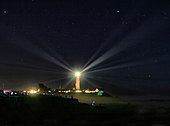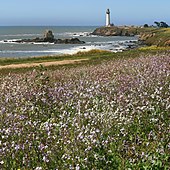Pigeon Point Lighthouse
 Pigeon Point Lighthouse in 2016 | |
 | |
| Location | Pigeon Point southern to San Francisco Bay California United States |
|---|---|
| Coordinates | 37°10′54.3″N 122°23′38.1″W / 37.181750°N 122.393917°W |
| Tower | |
| Constructed | 1871 |
| Foundation | stone |
| Construction | brick tower |
| Automated | 1974 |
| Height | 115 ft (35 m) |
| Shape | tapered cylindrical tower with balcony and lantern attached to workroom |
| Markings | white tower, black trim |
| Operator | Pigeon Point Lighthouse State Historic Park[1][2] |
| Heritage | National Register of Historic Places listed place, California Historical Landmark |
| Light | |
| First lit | 1872 |
| Focal height | 148 ft (45 m) |
| Lens | First order Fresnel lens (1872), DCB-24 aerobeacon (current) |
| Range | 24 nmi (44 km; 28 mi) |
| Characteristic | Flashing white 10s, Emergency light of reduced intensity when main light is extinguished. |
| Designated | 1977 |
| Reference no. | 77000337[3] |
| Designated | 1980 |
| Reference no. | 930[4] |
Pigeon Point Light Station or Pigeon Point Lighthouse is a lighthouse built in 1871 to guide ships on the Pacific coast of California. It is the tallest lighthouse (tied with Point Arena Light) on the West Coast of the United States. It is still an active Coast Guard aid to navigation. Pigeon Point Light Station is located on the coastal highway (State Route 1), 5 miles (8 km) south of Pescadero, California, between Santa Cruz and San Francisco. The 115-foot (35 m), white masonry tower, resembles the typical New England structure.
The lighthouse and the land around have been preserved as Pigeon Point Light Station State Historic Park, a California state park. The lighthouse is also listed on the National Register of Historic Places,[3] and designated as a California Historical Landmark.[4] The lighthouse is currently undergoing major renovations funded by the California state legislature in 2021.[5] Research published 2022 by the San Mateo County Office of Sustainability found that the lighthouse was vulnerable to erosion caused by sea level rise.[6][7]
History
[edit]
Pigeon Point Lighthouse is one of the most picturesque lighthouses on the Pacific coast. The tower stands on a rocky promontory and has long been a landmark for ships approaching San Francisco Bay from the south. This headland, and the lighthouse, took its name from the ship Carrier Pigeon that wrecked here in 1853.[8]
The lantern room of the tower is no longer equipped with the original first-order, 1000-watt Fresnel lens.[9] No longer illuminated for demonstration purposes,[10] the lens has 24 flash panels, is composed of 1008 hand-polished lenses and prisms and is capable of producing over 500,000 candlepower illumination. It was manufactured by the Henry-LePaute company in Paris, France, and was first lit at Pigeon Point at sunset on November 15, 1872.
Originally the tower was equipped with a lamp that burned refined lard oil (pig fat). In 1888, that lamp was replaced with a mineral oil (kerosene) lamp. To produce Pigeon Point's assigned characteristic of one white flash of light every ten seconds, the one ton lens rotated one time every four minutes. When observed from a distance, this resulted in the appearance of one white flash of light every ten seconds. The lens rotation was originally powered by a clockworks and 45 pounds (20 kg) weight. In 1926 the lighthouse was provided with electricity. Modern innovations were incorporated and the kerosene IOV lamp was replaced by a 1000 watt bulb, the clockworks by an electric motor and an electrically operated fog signal was eventually installed.
The lighthouse has been designated California Historical Landmark number 930. In 1972, the United States Coast Guard mounted a 24-inch (610 mm) aerobeacon on the front of the tower (now replaced by a smaller beacon) and officially retired the Fresnel lens from regular duty. The First order Fresnel lens is no longer lit to celebrate special occasions, such as the annual lighting of the lens, which usually occurred in mid-November (closest Saturday to November 15) the date of the original first lighting in 1872. The lens was removed from the top of the tower in November 2011, to now be displayed in the fog signal building, adjacent to the base of the lighthouse.[citation needed] The light outside the lens room, mounted on a small verandah at the top of the 100-foot (30 m) tower, rotating with six beams, is still an active aid to navigation.
The first order fresnel lens of the Pigeon Point Lighthouse originally came from the Cape Hatteras Lighthouse, which has the same lens characteristic. Following the deactivation of the original tower in 1870, the lens, which had only been installed in 1863 was removed and put into storage. Shortly thereafter in 1871 it was shipped to the west coast to be installed in the new lighthouse.[11]
Renovation
[edit]
The tower has been closed to tours since December 2001 because of the collapse of brickwork supporting outside access metal walkways on the top of the structure. Cast iron was used rather than steel. Cast iron absorbs water rather than repelling it like steel, thus the walkways are severely rusted, as are the major binding ring bands at the base of the tower. The California State Park system has promised repairs, but it is estimated that even if funds were available, it would be seven to ten years before the repairs would be completed. In July, 2010, Rep. Anna G. Eshoo (D-Palo Alto) stated that of the $3.4 million she requested for her district through the Fiscal Year 2011 Interior and Environment Appropriations Act, $250,000 will be allocated to restore the upper portion of the lighthouse.[12]
In 2021, an $18 million provision was made in the California state budget for the full restoration of the lighthouse.[5] In December 2023, California State Parks said in a press release that a $16 million rehabilitation project will start in early 2024 and is expected to be completed within two years.[13]
Contemporary uses
[edit]
The restored lighthouse keepers' housing has, since the mid-1960s, also served as a youth hostel for travelers. The hostel is operated by HI USA,[14] a nonprofit organization devoted to helping the young gain a greater understanding of the world and its people through hosteling.
The Pigeon Point Lighthouse is also a logo of the E. W. Scripps Company.
Astrophotography
[edit]This section's tone or style may not reflect the encyclopedic tone used on Wikipedia. (September 2024) |

Pigeon Point Lighthouse offers more than just a guiding light to seafarers; it's also a beacon for stargazers and astrophotography enthusiasts. On clear nights, the skies above the lighthouse burst into life with the dazzling display of the Milky Way, arching over the Pacific Ocean. The lighthouse's remote location away from the light pollution of major cities makes it an ideal spot for capturing the beauty of the cosmos. Photographers often find solace in the rhythmic sounds of the waves while waiting for the perfect shot of the celestial wonders above. The silhouette of the lighthouse against the backdrop of the star-studded sky creates a mesmerizing contrast, reminding us of the harmonious coexistence of human innovation and the natural universe.
Image gallery
[edit]-
Pigeon Point, c. 1870s, prior to construction
-
U.S. Coast Guard archive photo
-
Taken circa 1950 when fully operational including the Fresnel lens and fog signal
-
Pigeon Point Lighthouse with light on
-
Pigeon Point Light Station: Inside View of the Fresnel Lens
-
Pigeon Point Light Station Stairs in the Tower
-
Pigeon Point Lighthouse at blue hour
-
On pacific coast in summer
-
View of the lighthouse and surrounding rocks
-
Pigeon Point Lighthouse with wildflowers (view from the South)
See also
[edit]References
[edit]- ^ Rowlett, Russ. "Lighthouses of the United States: Northern California". The Lighthouse Directory. University of North Carolina at Chapel Hill. Retrieved June 12, 2016.
- ^ California Historic Light Station Information & Photography United States Coast Guard. Retrieved 12 June 2016
- ^ a b "National Register Information System". National Register of Historic Places. National Park Service. July 9, 2010.
- ^ a b "Pigeon Point Lighthouse". Office of Historic Preservation, California State Parks. Retrieved October 14, 2012.
- ^ a b "California coast: $18 million approved to restore historic Pigeon Point Lighthouse". The Mercury News. July 18, 2021. Retrieved January 19, 2022.
- ^ Driscoll, Curtis. "Half Moon Bay faces issues due to sea level rise". San Mateo Daily Journal. Retrieved January 19, 2022.
- ^ Howell, August (January 5, 2022). "Concerns aren't eroding as city dives in to study sea level rise". Half Moon Bay Review. Retrieved January 19, 2022.
- ^ D’Onfro, Jillian (December 4, 2023). "After 20 years without visitors, Calif. coastal landmark lays plan to bring them back". SFGATE. Retrieved December 5, 2023.
- ^ "Once majestic Pigeon Point Lighthouse - a legendary landmark - now in need of major restoration". Santa Cruz Sentinel. Archived from the original on April 2, 2012. Retrieved April 14, 2010.
- ^ Nemiroff, R.; Bonnell, J., eds. (November 26, 2007). "Moon Over Pigeon Point Lighthouse". Astronomy Picture of the Day. NASA.
- ^ Duffus, Kevin (2003). The Lost Light: The Mystery of the Missing Cape Hatteras Fresnel Lens. Raleigh, NC: Looking Glass Productions. pp. 161–167. ISBN 1-888285-21-4.
- ^ Hmbreview.com
- ^ "Pigeon Point Lighthouse Rehabilitation Project to Begin in Early 2024". California State Parks. December 4, 2023. Archived from the original on January 16, 2024. Retrieved February 8, 2024.
- ^ "Hiusa.org". Archived from the original on June 17, 2010. Retrieved May 20, 2010.
- ^ "Instagram". www.instagram.com. Retrieved January 21, 2024.
Further reading
[edit]- California Department of Parks and Recreation (2002). Pigeon Point Light Station State Historic Park. Sacramento, CA: California State Parks. OCLC 56543458.
- Perry, Frank (1986). The history of Pigeon Point Lighthouse. Soquel, CA: GBJ Pub. ISBN 978-0-943896-02-1.
- Perry, Frank (Spring 1999). "Legacy of the Carrier Pigeon - A History of the Pigeon Point Light Station". The Keeper's Log. XV (3). United States Lighthouse Society.
- Semones, JoAnn (2007). Shipwrecks, scalawags, and scavengers: the storied waters of Pigeon Point. Palo Alto, CA: Glencannon Press/Maritime Books. ISBN 978-1-889901-42-8.
External links
[edit]- Pigeon Point Light Station State Historic Park
- Carrier Pigeon / CINMS Shipwreck Database
- Lighthouse Friends / Pigeon Point History
- Westkueste USA: Pigeon Point Lighthouse History and description of the Pigeon Point Lighthouse with pictures (in German)
- California State Historic Parks
- History of San Mateo County, California
- History of the San Francisco Bay Area
- Lighthouses completed in 1871
- Lighthouses in the San Francisco Bay Area
- Lighthouses on the National Register of Historic Places in California
- National Register of Historic Places in San Mateo County, California
- Parks in San Mateo County, California
- Protected areas established in 2000
- Transportation buildings and structures in San Mateo County, California











